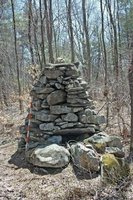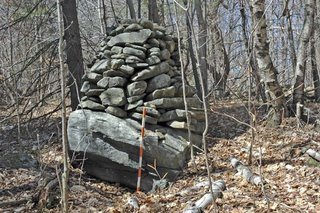
All photos courtesy of Norman Muller & Peter Waksman
In a lightly wooded area in Washington, Massachusetts, there lies a curious pile of stones. New England, of course, is full of piled stones- the results of centuries of efforts to clear fields from a seemingly endless quantity of unwanted rock. Rocks piled for walls, boundary markers, burial markers, or just to get them out of the way.
New England is also rife with other kinds of rock formations as well, tucked away in remote forested areas, and requiring considerable effort to construct for no apparent practical reason. The cairn in question, along with several related structures nearby, fall into this latter category, and form part of an enigma that has attracted much speculation over the years. In a reasonably open spot on a piece of property on an old country road stands a 7 foot tall cairn of carefully piled stones that has been referred to by some as the Washington Mystery Monument (not to be confused with Monument Mountain ‘mystery’ cairn so thoroughly covered by Lion G. Miles in a recent Advocate article). This formation, along with several other similar stone structures in secluded spots in Washington, constitutes an interesting bit of unsolved local history. It has become customary to withhold from print the exact locations of these sites, both out of respect and to prevent vandalism, and I shall continue this trend here.

Despite the lack of disclosure and general obscurity of these Washington structures beyond local circles, a few determined investigators have examined them, and pondered their origins and meanings. The primary stone formation is comprised of a conical pile seven feet in height, and about seven feet wide at the base. The stones, some weighing hundreds of pounds, are stacked neatly and carefully, with no trace of mortar or clay packing. The tower tapers off at the top to a width of about three feet, and on top, single quartz stone has been placed in the center. At the base of the structure, a small chamber opens facing north. The chamber is about two feet high and a foot deep; in 1969, a reporter for the Springfield Republican pointed out its resemblance to a hearth, but lacking chimney.

A short distance from this obelisk there are two concentric stone circles, deeply implanted in the ground and largely grown over with moss. The outer circle is about 4 feet in diameter, the inner circle 3, inside of which is a large quartz rock. These structures are clearly related to each other, and, I would venture, to other structures not far away. Along a nearby ridge can be found several platform cairns, several of which are built atop boulders. One of these also boasts a small chamber like opening at its base.

Not far from the road, on another secluded piece of property, there is yet another chamber, wider and deeper than the others, this one built directly into a hillside. Centered just above the opening is a rock that stands out from the others, a single piece of hematite.
For many years now, interested parties have been trying to establish the origins of Washington’s crystal-topped, hearth-like cairn and its cousin sites. It is not mentioned in the earliest Berkshire sources, and it is nowhere near where any property lines have run in historically recorded times. A woman born around 1900 on the property where the main cairn stands is reported to have said that the structure had already been there for some time when her father first settled the land, in the 1880s or 90s. The “Stockbridge” Indians are known to have had a summer encampment in that area until the late 1750s, but nothing about any such structures was recounted to those colonial settlers who interfaced with these Berkshire natives.

Even without a clear historical picture of their construction, many interesting observations can be made between this apparently interrelated network of structures, as well as their similarities to other megalithic constructions around New England. The chamber space built into the cairn is a fairly unusual feature, but not unheard of. In Ashfield, Massachusetts, there are several conical stone piles with cavities similarly built into the base. Like the one in Washington, the Ashfield chambers also face due north. At a major site in New York, three out of several hundred cairns were found to have such openings as well. Test digging dug at the base of the opening revealed a six inch layer of charcoal a foot and half below ground. This suggests something burning for extended periods, hinting at the possibility that these spaces may have served for making ritual offerings. The presence of hematite at the hillside chamber is also quite interesting. Hematite was frequently used in making the red ochre so often associated with burial and ritual traditions.
Some have seen in these structures a similarity to altars used for burning offerings by ancient Israelites, stone cairns with fires lit on top. Many American stone piles do seem to bear a resemblance to ones found in Arabia, some in close proximity to stone circles. Others have pointed to them as evidence for early American exploration by Irish, Norse, and other European groups, drawing connections to analogous formations in many ancient cultural groups. It may be an indication that vastly divorced peoples in similar stages of development come to similar conclusions about spirituality. But why these particular patterns of construction? What fundamental concepts do they embody?
I will say that judging from their condition, most of these megaliths seem to be less ancient than the stone tunnels in nearby Goshen, probably built by a more recent culture. They are, however, no less mysterious. They are indelible fountains of possibilities, Rorschach tests etched permanently into the landscapes for future generations.
Sources:
The Search for Lost America: Mysteries of the Stone Ruins in the United States
By Salvatore Michael Trento
“Monument poses mystery in the Berkshires.” Wadsworth R. Pierce, The Springfield Union, July 17 1969
“New information on an interesting Berkshires site.” NEARA Newsletter v.5 , March 1970
Rock Piles:
http://rockpiles.blogspot.com/2006_04_02_rockpiles_archive.html

How nicely written.
ReplyDeletei know where there are arox.40 stone piled on a bench of a mountain across a hollow from a very large cave.i know the cave was inhabited by early indians(woodland and older)judging by artifacts ive seen from the cave.i dont really know if they are related and would love to know more.i have also found other signs that were left(small stones of limestone piled on a large stone with a pie shaped stone of brown sand stone only visable when 3 stones are removed from the top and it points towards the above said cave,only the square end is visable of the pie shaped rock until the stones are removed).i also discovered some very interesting stone carvings on the cave wall.it is only visable at the first and last light.it is very large(aprox.25 ft tall and 30ft wide).it is my personal oppinion is that it may be myan influince.i didnt think that untill i saw the same carving on the cover of a book months after finding it.what was on the book was the myan sun god the jaguar.but everyone says there were no myan in north alabama.nobody will take it serious and even come look. i just want to know what it is.any answers?
ReplyDeleteCan you take some pictures of the mural? I know a Mayan expert I could show them too.
DeleteI came through Ashfield MA in 1969 visiting Norman Pike, a retired Ford dealer &local historian. He showed me old stone wells and a phd thesis from Ohio State Univ.with maps of them down the st lawrence to the Ohio, saying that the irish were here first. having been chased by vikings and giving indians their resistive powers over brew, no doubt. This is the first article I have seen on this stuff since and I have looked, Thanks. Do you have more? tolstoy@erols.com
ReplyDeleteIndeed very well written. Longtime stones explorer here having been turned on to these mysteries by Sal Trento back in the 70s when he shared his knowledge with all of us in a continuing ed class in Concord, Mass. Found your web site via...Stone Prayers of Southern NE. Great stuff! Thanks to all of you guys for taking the time to blog.
ReplyDelete